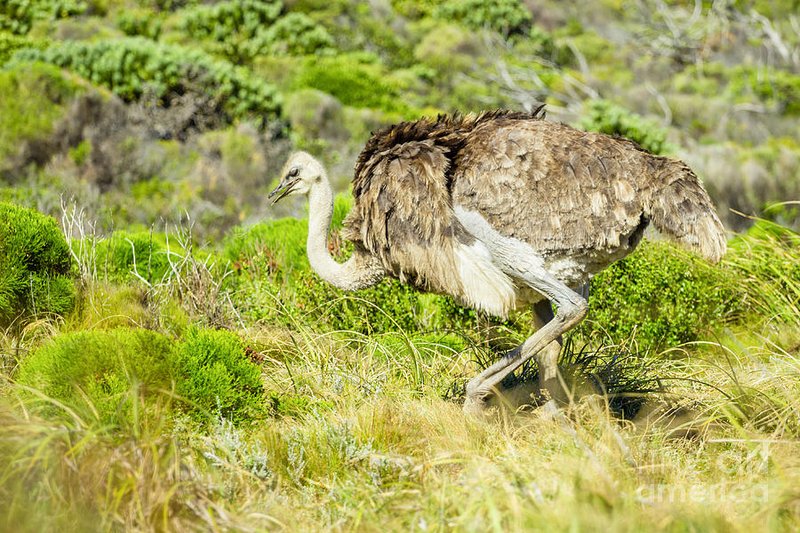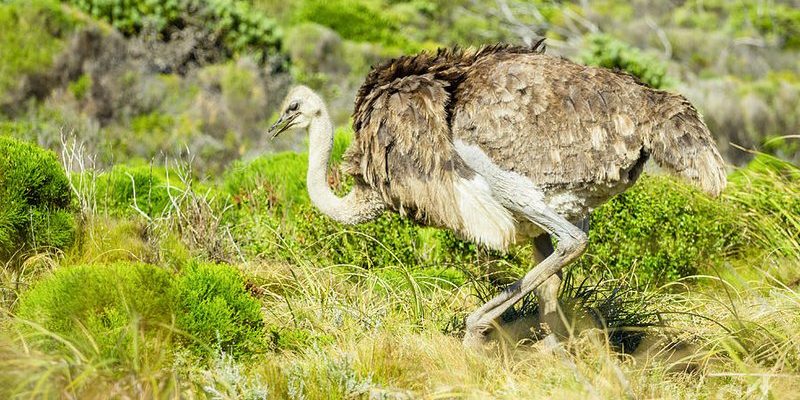
You might think of birds as lightweight, soaring creatures, but the ostrich is a different story. Standing tall at up to 9 feet and weighing over 300 pounds, ostriches are the largest birds on the planet. These flightless wonders are more akin to robust land animals that have unique adaptations perfect for their environment. Imagine a bird that can’t take to the skies but finds other astonishing ways to survive and thrive on the ground. It’s quite fascinating!
Ostriches hail from the African savannah, where they roam in herds, exhibiting a range of captivating behaviors that can leave anyone mesmerized. What makes them so striking? Well, their long necks and legs give them a graceful yet powerful appearance, while their personality traits—curious and somewhat comical—add to their charm. So, let’s dive into what makes these incredible birds tick and discover a few fun facts along the way!
Physical Characteristics
The ostrich’s remarkable structure is a key part of its identity. These birds have a unique body shape that enables them to survive in harsh environments. Their long legs are designed for speed; at full stretch, they can reach speeds of up to 45 miles per hour. That’s faster than many running athletes! The legs are also strong enough to deliver powerful kicks against predators, making them formidable despite their size.
Their feathers are another interesting aspect. Unlike most birds, ostrich feathers are soft and fluffy, almost like a down-filled blanket. The feathers help regulate body temperature and serve a dual purpose in courtship displays, where males fan out their plumage to attract females. This visual spectacle is one you wouldn’t want to miss if you ever encounter these birds in the wild.
Apart from their striking physical attributes, ostriches possess large, expressive eyes. These can be up to 2 inches in diameter, providing them with excellent vision. They can see long distances, which is crucial for spotting potential threats in the open savannah. Their vision is complemented by a keen sense of hearing, making them well-equipped to detect dangers lurking nearby.
Habitat and Distribution
Ostriches are native to the African continent, specifically the savannah and plains regions. Their habitats range from open grasslands to semi-arid regions, which allows them to thrive in a variety of environments. What’s fascinating is their ability to adapt; while they prefer wide-open spaces to run, they can also cope with sparse bushes or trees that provide necessary shade from the sun.
You might be wondering how such large birds manage to avoid threats in their habitat. Well, their strategy primarily revolves around speed. In the wild, ostriches often run in a zigzag pattern to confuse predators like lions or hyenas. They also rely on their large groups for safety, as there’s safety in numbers!
Their distribution is primarily in countries like South Africa, Namibia, Botswana, and Kenya. However, ostriches have also been introduced to other parts of the world, like the United States and Australia, for farming and agricultural purposes. These birds are quite resilient, adjusting to their new environments and sometimes even thriving beyond their natural habitats.
Diet and Feeding Habits
Ostriches are primarily herbivores, and their diet consists mainly of grains, seeds, and various plants. However, these birds are opportunistic feeders; they will also consume insects and small animals if the opportunity arises. Their digestive system is specially designed to process tough plant materials, which enables them to extract necessary nutrients from their food efficiently.
One interesting behavior to note is how ostriches consume sand and small stones. This might sound odd, but these gritty substances help grind the food in their gizzards, acting as natural aids in digestion. You could say they have a unique method of “chewing” food without actual chewing! This adaptation is essential for their diet and overall health.
Ostriches are also known for their impressive foraging techniques. They use their keen eyesight to locate food across sprawling landscapes. While they can forage alone, they often prefer to eat in groups, which can help them locate food more efficiently and be on the lookout for potential dangers. Imagine a buffet of delicious greens, all ready for these picky eaters!
Reproduction and Parenting
The reproductive habits of ostriches are quite fascinating. Mating rituals can be elaborate. Males perform impressive displays to woo females, including strutting, booming calls, and feather-fanning. Once a male successfully attracts a female, they will mate and lay eggs in a communal nest, which can have up to 60 eggs at one time!
The eggs are large, about the size of a grapefruit, and have tough shells that are remarkably resistant to damage. After the female lays the eggs, both parents take turns incubating them. This collaborative effort is crucial, as it ensures the eggs are kept warm and safe from predators. It’s a team job, and they work remarkably well together.
Once the chicks hatch, they’re precocial, which means they can stand and run almost immediately. This trait is vital for their survival, especially since young ostriches are vulnerable to predators. The parents stay close by, guiding their chicks and teaching them the ways of the world. It’s heartwarming to see how they form strong family bonds, working together to help the next generation thrive!
Interesting Facts About Ostriches
| Scientific Name: | Struthio camelus |
| Height: | 6 to 9 feet |
| Weight: | 220 to 350 lbs |
| Speed: | Up to 45 mph |
| Diet: | Herbivorous, feeding on plants and insects |
| Lifespan: | 30 to 40 years in the wild |
Ostriches in Culture and History
Throughout history, ostriches have held significant cultural meaning across different societies. In ancient Egypt, they represented the concept of truth and justice, often associated with the goddess Ma’at who was depicted with an ostrich feather. The feather was a symbol of balance and order, making it highly revered.
In addition to spiritual meanings, ostriches have also been part of folklore and art. Their striking appearance has inspired various artistic depictions, and they often symbolize something unique and exotic. Even in modern times, they are popular in entertainment, seen in movies and zoos, where people marvel at their size and humorous antics.
The ostrich’s feathers also played a significant role in fashion and commerce. In the late 19th and early 20th centuries, ostrich feathers were highly sought after for decorating hats and clothing, which led to large-scale ostrich farming. This was a booming industry that not only showcased the bird’s beauty but also raised awareness of their conservation needs.
Conservation Status
Despite their resilience, ostriches face challenges due to habitat loss and hunting pressures. The International Union for Conservation of Nature (IUCN) lists the common ostrich as “Least Concern,” but local populations can be at risk, particularly in areas where their habitats are threatened. Conservation efforts focus on habitat preservation and sustainable farming practices to ensure these magnificent birds continue to thrive.
In some regions, ostrich farming has become a viable alternative for income, benefiting both people and wildlife. By raising ostriches, communities can support their economies while helping to conserve wild populations. It’s a symbiotic relationship that illustrates how people can positively impact wildlife conservation.
Moreover, various wildlife organizations are working to educate and raise awareness about the importance of protecting ostriches and their habitats. Community-based conservation programs also encourage local populations to engage in preserving the environment, highlighting the essential role these birds play in the ecosystem.
FAQ
Can ostriches fly?
No, ostriches cannot fly. They are flightless birds that have evolved for life on land. Their anatomical structure, particularly their heavy body and small wings, prevents them from taking to the skies. Instead, they have developed incredible running abilities to escape threats.
How fast can ostriches run?
Ostriches are among the fastest birds on land, capable of reaching speeds up to 45 miles per hour. Their long legs and powerful muscles allow them to sprint short distances, making them adept at evading predators. In fact, they can maintain a steady pace of around 30 miles per hour over longer distances as well.
What do ostriches eat?
Ostriches primarily feed on a herbivorous diet, which includes grasses, seeds, and leaves. They may also consume insects and small animals opportunistically, showcasing their adaptability to available food sources. This varied diet helps them thrive in their natural habitats.
How do ostriches protect themselves from predators?
Ostriches use speed as their primary defense mechanism. They can run fast enough to escape many threats. Additionally, they rely on visual acuity and their social nature, staying in groups to help keep an eye out for danger. Their ability to kick powerfully also serves as a last resort defense.
Are ostriches social animals?
Yes, ostriches are social birds that often live in groups, which can range from a few individuals to more than fifty. Living in flocks helps them protect one another from predators and allows for more efficient foraging. They communicate through a variety of vocalizations and body language.
How long do ostriches live?
In the wild, ostriches typically have a lifespan of 30 to 40 years, although they can live longer in captivity. Their longevity can vary depending on factors like environment, availability of food, and exposure to predators. Proper care in farm settings can help ensure they reach their full lifespan.
Can ostriches swim?
While ostriches are not known for swimming, they can float and paddle when necessary. However, they generally prefer terrestrial environments and have not adapted to spending much time in water. Their primary strength lies in their running capabilities rather than water-based activities.
Do male and female ostriches look different?
Yes, there are notable differences between male and female ostriches. Males typically have black feathers with white wing tips, making them more striking and easily identifiable. Females, on the other hand, have a more muted brown color that helps them blend into their surroundings, providing better camouflage while nesting.
Are ostriches kept as pets?
While it’s possible to keep ostriches on private farms or large properties, they are not typical household pets. Their size, dietary needs, and social behavior require substantial space and care. Potential owners should do thorough research and consult with professionals before considering an ostrich for domestic life.
How do ostriches communicate?
Ostriches communicate through a combination of vocalizations and body language. They can produce a range of sounds, including booming calls and hisses, to convey messages to one another. Additionally, body postures and movements play a significant role in their social interactions.
Can ostriches be found outside of Africa?
While ostriches are native to Africa, they have been introduced in various parts of the world for farming, tourism, and conservation purposes. Countries like the United States and Australia have ostrich farms where they are raised for their feathers, meat, and eggs, showcasing their adaptability beyond their native habitats.
What is the significance of ostrich feathers?
Ostrich feathers hold historical and cultural significance, often associated with luxury and fashion. In ancient Egypt, they symbolized truth and justice. Today, they are popular in fashion and decor, representing elegance. Their unique qualities have made them desirable for various uses throughout history.

